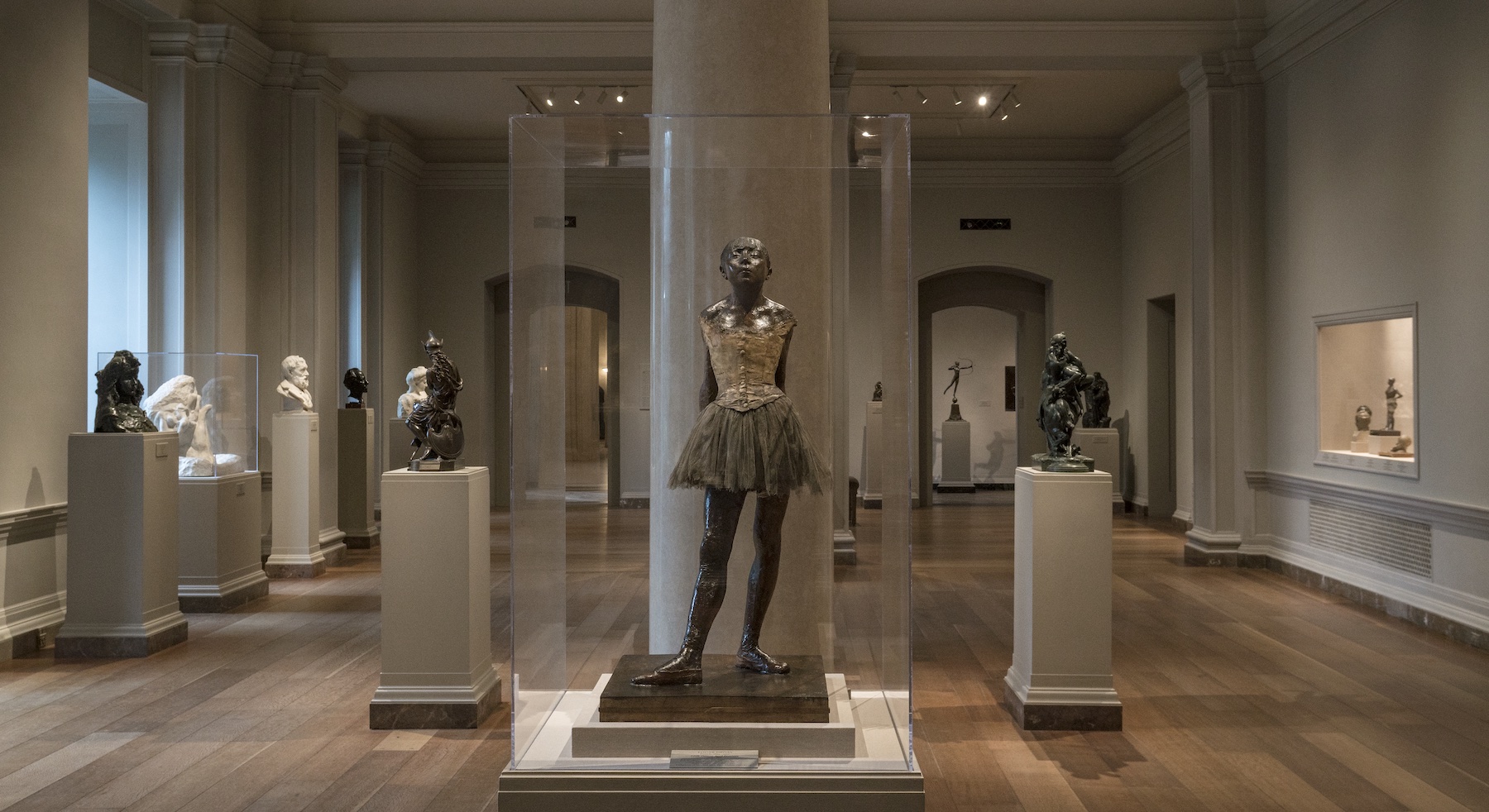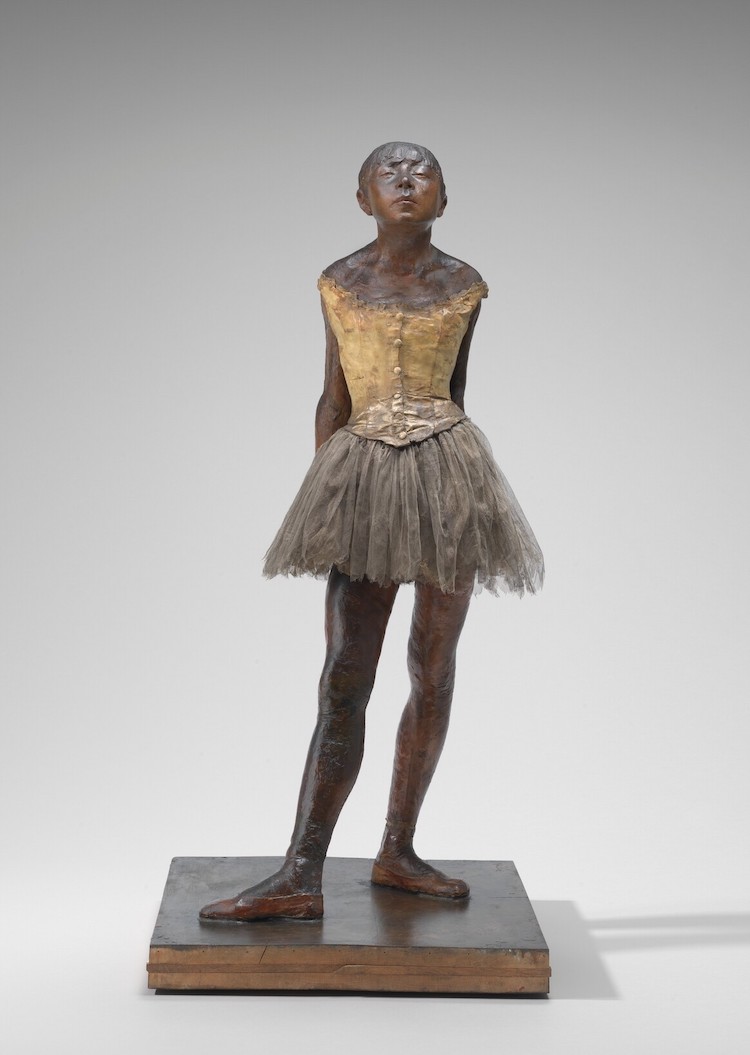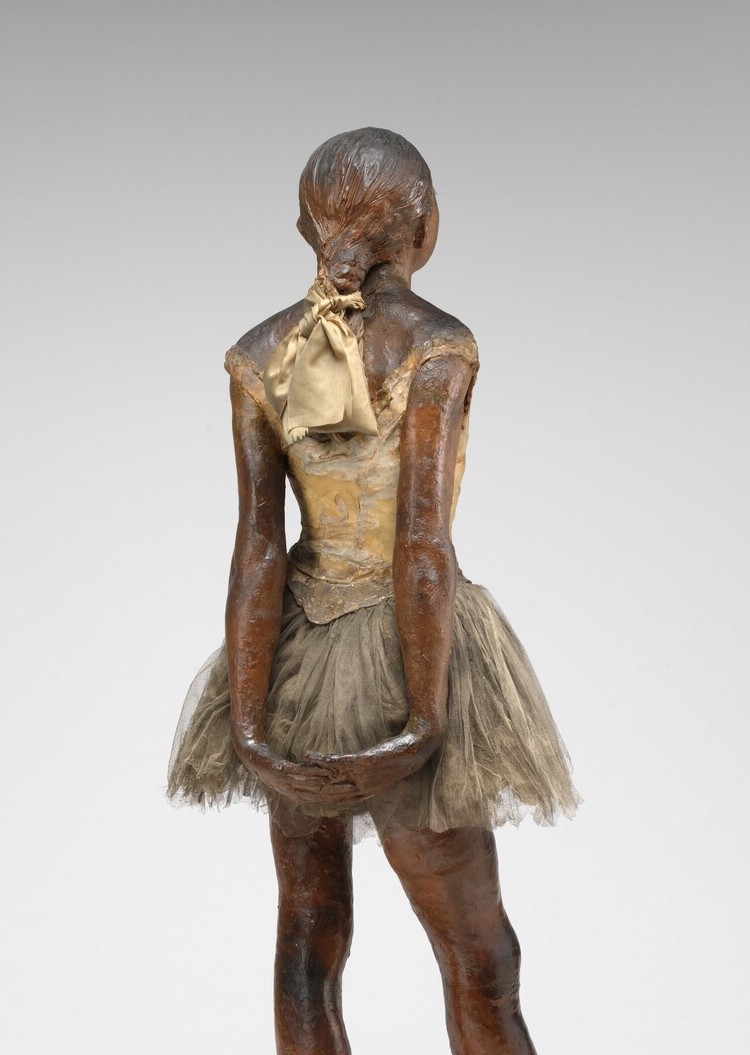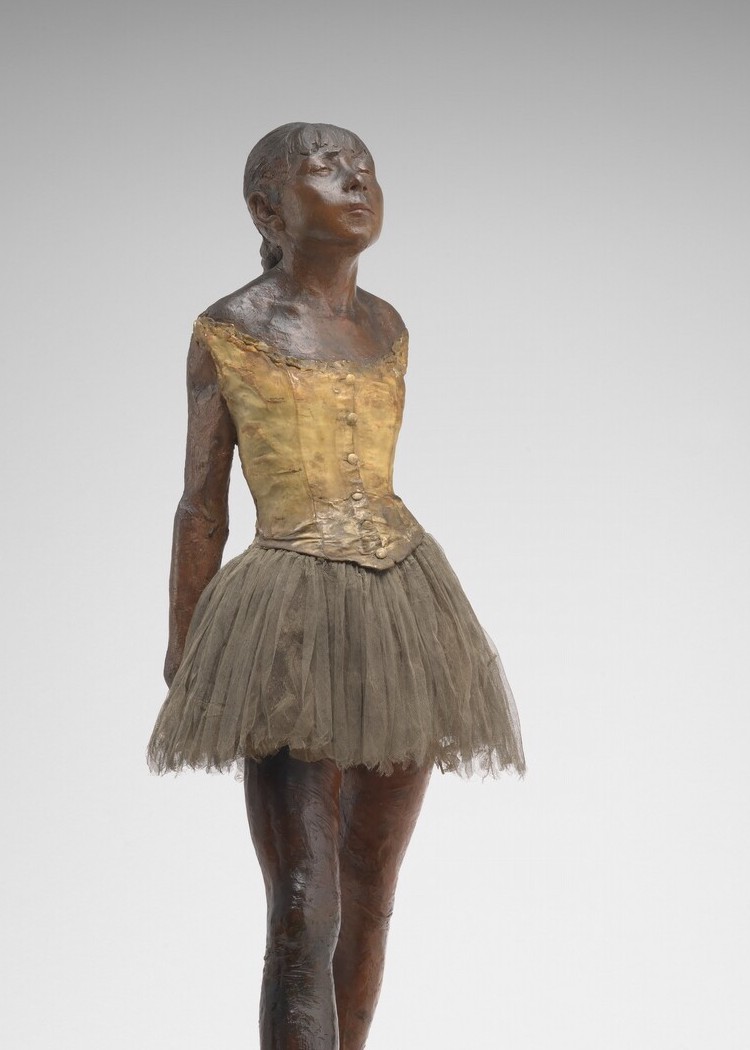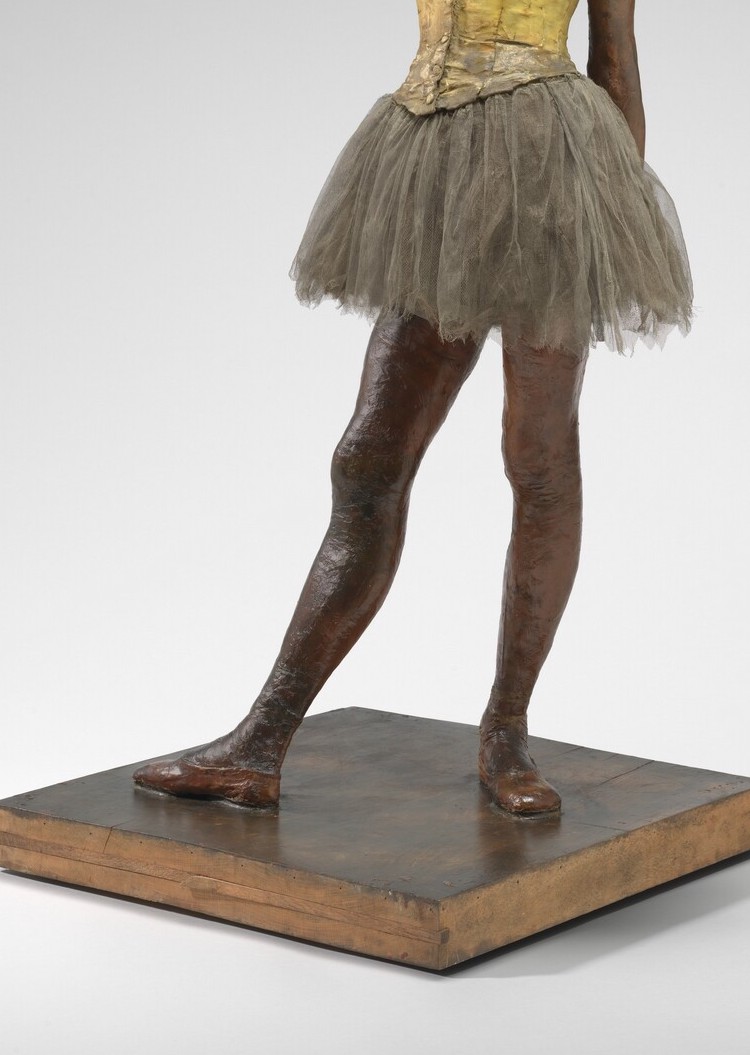Bronze replicas of Edgar Degas’s Little Dancer Aged Fourteen fill museums around the world. But the artist himself only created one Little Dancer. Made of beeswax, clay, metal, wood, and rope, the sculpture stands proudly in our galleries, surviving for a good century longer than expected.
The French impressionist debuted his figure of teenage ballerina Marie van Goethem in 1881. Critics were shocked by the three-foot sculpture. They called it ugly and repulsive. Degas had never publicly exhibited a sculpture before. And he never would again.
After Degas died in 1917, his heirs discovered Little Dancer in his studio. They commissioned the bronze casts which most are familiar with today.
In the 100 years since the bronzes were made, public opinion of the sculpture has swung in the opposite direction. So how did it go from reviled to admired and iconic? And among the dozens that exist, what makes our Little Dancer so precious?
Degas, the Secret Sculptor
During his lifetime, Degas was known for his paintings. But in the privacy of his studio, he studied movement by making dozens of sculptures of dancers, bathing women, and horses with jockeys. However, he only ever exhibited Little Dancer.
But it took Degas a while to get there. “Degas rarely considered anything finished. He reworked, and reworked, and reworked,” notes Alison Luchs, curator of early European sculpture at the National Gallery. “He was never satisfied.”
The artist made over 20 sketches and studies of Marie van Goethem standing with her right foot extended in ballet’s fourth position and her hands clasped behind her back. He drew her pose from every angle. He designed an armature (framework) for the sculpture. He even made plans to exhibit Little Dancer in 1880, but changed his mind.
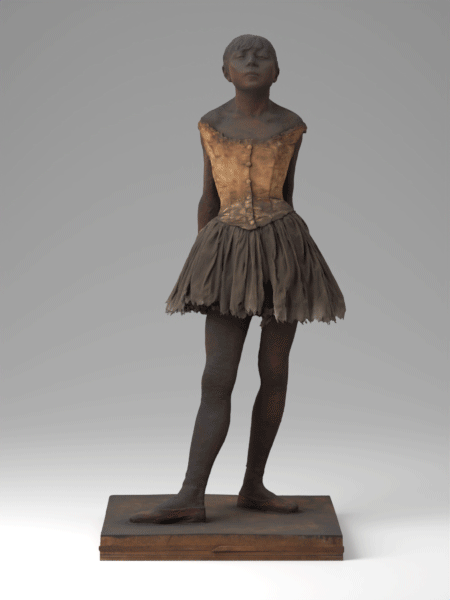
3D photogrammetry shows a 360-degree view of Degas’s Little Dancer.
How Degas Made Little Dancer
Few people know Little Dancer better than Daphne Barbour, a senior conservator of objects at the National Gallery. Barbour has studied the sculpture for years. Together with curators, conservators and scientists, she’s conducted groundbreaking research into the work’s construction and materials.
Little Dancer is built around a framework of intersecting hollow lead pipes. They act like the sculpture’s skeleton—its spine, hips, and legs. Plates screwed into the base serve as the feet. Paint brushes are the bones in its arms. Padding and pieces of wood wrapped with rope build up the shape of the figure.
Degas added a layer of clay over the skeleton. Over that, he applied layers of molten beeswax.
“Wax, or clay, was so appealing to him because of its malleability. He could work and rework a sculpture using them,” explains Barbour.

Left: Radiograph, overall frontal view of Degas’s Little Dancer
Right: Schematic diagram of the internal armature of Little Dancer. Illustration by Julia Sybalsky and Abigail Mack (2007).
Degas carefully molded the wax, smoothing the figure’s skin, modeling the face, and even making fingernails on the hands.
The artist added pigment to the wax to create flesh tones. On some parts, like the pinkish lips, he painted right onto the sculpture.
Finally, Degas added the dancer’s outfit. A manufactured cotton bodice was tailored to the figure. He cut the shoulder straps to slip the bodice over the torso and covered it in a layer of beeswax to blend it with the sculpture. To make the tutu, Degas layered cotton and silk netting or fabric.
The figure also wears real linen ballet slippers, altered to fit its feet. Degas painted them with pink colored beeswax.
The figure’s hair is a braided wig of dark blonde human hair, also covered in wax. The final touch is a soft golden silk ribbon around the braid.
Even with decades of care by conservators, these many organic elements make Little Dancer prone to damage. Cracks on the legs are at risk of growing. Pieces of cotton and silk tutu (probably the very garment from 1881) can blow off with the slightest gust of air.
The sculpture has only been moved a few times since it arrived at the National Gallery in 1999. Barbour explains why: “Every time you move it, these separate things move independently.”
New technology helps us monitor Little Dancer better than ever before. The sculpture had to be taken off view and assessed for damage after an attack in April 2023. This gave photographer Kurt Heumiller the opportunity to scan it in 3D.
The new imaging helps curators and conservators ensure that Little Dancer can live on for generations. It allows them to better measure and address any changes over time.
Little Dancer’s Reception
The sculpture is beloved today, but when Degas displayed Little Dancer at the 1881 impressionist exhibition, writers had no shortage of criticism.
First, there were its materials. Wax was for anatomical or anthropological specimens. In art, it was used mostly for preliminary models. It wasn’t meant for finished works that would be exhibited. And dressing the sculpture in real clothing made it closer to a doll or mannequin than a work of art.
Then there was the sculpting style. Degas didn’t idealize Van Goethem. He modeled her as he saw her. Skinny legs and arms. A rounded belly. Broad face. Jutting chin. One critic called the sculpture “simply hideous.”
Finally, there was the subject—a young student dancer at the Paris Opéra Ballet. Ballerinas in 19th-century Paris were not considered glamorous or elegant. Most came from working-class backgrounds. (Van Goethem was the daughter of a tailor and a laundress.) And wealthy men with paid Opéra subscriptions that allowed them to go backstage preyed on the young dancers, who were disparagingly called “the opera rats.” As in his paintings, Degas captured the dark undercurrent of the glittering ballets.

Edgar Degas, Dancers Backstage, 1876/1883, oil on canvas, Ailsa Mellon Bruce Collection, 1970.17.25
After the 1881 exhibition, Little Dancer returned to Degas’s studio and never left again during his lifetime.
Little Dancer’s Rediscovery
Degas’s heirs discovered Little Dancer, along with his other wax sculptures, following his death in 1917. Many were in a bad state. One account claimed that the dancer’s arms had fallen off.
The family contracted a foundry to cast into bronze 74 sculptures they believed to be in good enough condition to withstand the process. (Even so, four did not survive casting.)
According to legend, Degas’s wax originals remained in the Paris foundry, hidden there during World War II. But in the mid-1950s, they went on view at the Knoedler Gallery in New York, and Paul Mellon purchased the whole group. Surprisingly the French government had no interest in keeping them. The Louvre Museum’s sculpture curator believed the waxes had been “worn out” in the casting process—and the museum owned a complete set of the durable bronzes.
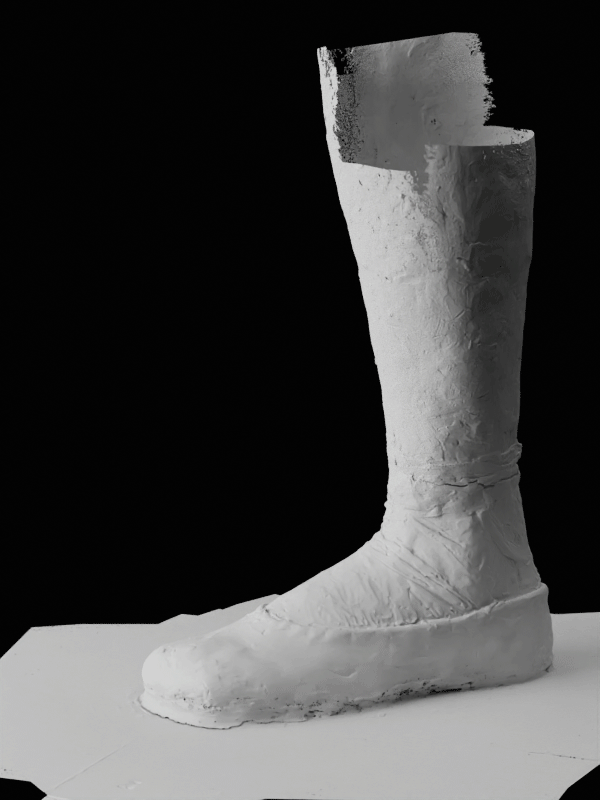
3D structured light scans show a crack along the ankle of Degas’s Little Dancer. Structured light scans allow conservators to precisely measure fine details, such as the length of the crack, and monitor any changes.
Little Dancer’s Redemption
By the 1920s, the public could better appreciate Degas’s modern subject and realism. Collectors and museums around the world bought the bronze versions of Little Dancer. The sculpture went from forgotten to one of Degas’s most recognizable works.
The same reasons that most critics initially disliked Little Dancer are the reasons so many people now love it.
At 14, Van Goethem would have been moving up to the next rank of dancers. Reflecting her adolescence, she was a girl in transition. As Luchs says, “she’s an image of potential.”
And despite the perception of her background and her rank as a student, she stands with dignity. Her pose is strong. Her upturned face creates an air of determination. She is a dancer.
Against all odds, and thanks to the care and expertise of our curators and conservators, the original wax sculptures in our collection have now survived for more than a century. The original Little Dancer Degas still stands, and even the specialists who preserve it are in awe. “Ideally, we want people everywhere to know and understand this object,” says Heumiller. “But everyone who can, should come in their lifetime and see it.”
